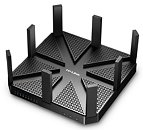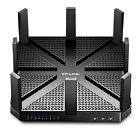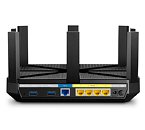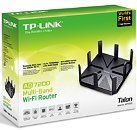Wednesday, May 18th 2016

TP-Link Announces the World's First 802.11 ad Router, The Talon AD7200
TP-LINK, a leading global provider of consumer and business networking products, today announced the availability of Talon AD7200, the world's fastest router with the latest, most powerful wireless technology available, 802.11ad. Talon AD7200 routers run a new 60GHz band that reaches speeds significantly faster than Gigabit Ethernet. Users can now download 100 photos in less than a second, an HD movie in less than 40 seconds and a full 4K movie in less than eight minutes-all over an interference-free home wireless network. The Talon AD7200 is currently available at Newegg.com, Fry's Electronics and Micro Center retail stores.
"With the Talon AD7200, we've bringing consumers the fastest Wi-Fi ever made," said Lewis Wu, executive vice president of TP-LINK USA. "We're excited to see the response from our customers when they are able to stream and download 4K movies in the blink of an eye, or transfer huge files and photos in seconds. It's a completely different experience than most of us are used to from our network, and we're excited to deliver this innovative technology to the world for the very first time.""802.11ad technology powers a brand new class of experiences in the connected home, including lag-free wireless docking, multiple 4K video streams, and instantaneous content sharing, gaming and downloading," said Chris Taylor, director of RF and wireless components, Strategy Analytics. "We expect that Wireless AD technology will continue to gain traction with consumers who need high-bandwidth interoperability in high-density environments."
Multi-Band & Leading Antenna Design for Whole-Home Coverage
As the number of Wi-Fi devices in the home steadily rises, consumers will require faster, most reliable Wi-Fi to manage the high bandwidth across their home network. The Talon AD7200 runs multiple bands at an unprecedented 7.2 Gbps to provide complete coverage for all your devices.
The new 60GHz (4600Mbps) band is a perfect single-room Wi-Fi solution that supports more simultaneous connections without interference. On top of 60GHz, the router's 5GHz (1733Mbps) and 2.4GHz (800Mbps) bands cover the rest of your home in powerful AC2600 Wi-Fi.
The Talon AD7200 uses eight high-gain antennas-seven external, one internal-as well as an external 60GHz antenna array to create strong Wi-Fi connections across your home. Beamforming helps the router locate Wi-Fi devices and focus its wireless signal in their direction.
Reliable Connections & Better Performance
The 60GHz band uses beam-steering technology to detect objects and direct the Talon AD7200's Wi-Fi along the clearest path to devices. If there's something between the router and a wireless device, like a chair or couch, beam-steering sends Wi-Fi around it for a stronger connection.
MU-MIMO allows the Talon AD7200 to simultaneously communicate with multiple devices on its 2.4 GHz and 5 GHz bands, reducing wait times and speeding up connections. With MU-MIMO, more users can be online at once without affecting the router's performance.
Faster Speeds & A More Powerful Network
A 1.4GHz dual-core processor balances the demands of your devices to keep their connections fast and uninterrupted. Four-Stream creates faster Wi-Fi connections by adding an extra data stream to both the Talon AD7200's 5 GHz and 2.4 GHz bands. The four total streams per band greatly increases Wi-Fi speed, letting you enjoy intensive activities, like gaming or watching movies in 4K, without lag.
Now, you can game online, stream movies, download files and share media while the powerful dual-core processor seamlessly manages each Wi-Fi band, every connection and all of the router's hardware and software.
Key Features:
The Talon AD7200 Multi-band Wi-Fi Router with a MSRP of $349.99 USD is available exclusively online at NewEgg.com and exclusively in-store at Fry's and Microcenter retail locations.
For more information, visit the product page.
"With the Talon AD7200, we've bringing consumers the fastest Wi-Fi ever made," said Lewis Wu, executive vice president of TP-LINK USA. "We're excited to see the response from our customers when they are able to stream and download 4K movies in the blink of an eye, or transfer huge files and photos in seconds. It's a completely different experience than most of us are used to from our network, and we're excited to deliver this innovative technology to the world for the very first time.""802.11ad technology powers a brand new class of experiences in the connected home, including lag-free wireless docking, multiple 4K video streams, and instantaneous content sharing, gaming and downloading," said Chris Taylor, director of RF and wireless components, Strategy Analytics. "We expect that Wireless AD technology will continue to gain traction with consumers who need high-bandwidth interoperability in high-density environments."
Multi-Band & Leading Antenna Design for Whole-Home Coverage
As the number of Wi-Fi devices in the home steadily rises, consumers will require faster, most reliable Wi-Fi to manage the high bandwidth across their home network. The Talon AD7200 runs multiple bands at an unprecedented 7.2 Gbps to provide complete coverage for all your devices.
The new 60GHz (4600Mbps) band is a perfect single-room Wi-Fi solution that supports more simultaneous connections without interference. On top of 60GHz, the router's 5GHz (1733Mbps) and 2.4GHz (800Mbps) bands cover the rest of your home in powerful AC2600 Wi-Fi.
The Talon AD7200 uses eight high-gain antennas-seven external, one internal-as well as an external 60GHz antenna array to create strong Wi-Fi connections across your home. Beamforming helps the router locate Wi-Fi devices and focus its wireless signal in their direction.
Reliable Connections & Better Performance
The 60GHz band uses beam-steering technology to detect objects and direct the Talon AD7200's Wi-Fi along the clearest path to devices. If there's something between the router and a wireless device, like a chair or couch, beam-steering sends Wi-Fi around it for a stronger connection.
MU-MIMO allows the Talon AD7200 to simultaneously communicate with multiple devices on its 2.4 GHz and 5 GHz bands, reducing wait times and speeding up connections. With MU-MIMO, more users can be online at once without affecting the router's performance.
Faster Speeds & A More Powerful Network
A 1.4GHz dual-core processor balances the demands of your devices to keep their connections fast and uninterrupted. Four-Stream creates faster Wi-Fi connections by adding an extra data stream to both the Talon AD7200's 5 GHz and 2.4 GHz bands. The four total streams per band greatly increases Wi-Fi speed, letting you enjoy intensive activities, like gaming or watching movies in 4K, without lag.
Now, you can game online, stream movies, download files and share media while the powerful dual-core processor seamlessly manages each Wi-Fi band, every connection and all of the router's hardware and software.
Key Features:
- Wireless AD: Supports 802.11ad, the latest breakthrough in wireless technology, for Wi-Fi speeds faster than Gigabit Ethernet
- AD7200 Multi-Band: Runs three separate Wi-Fi bands, 60GHz (4600Mbps), 5GHz (1733Mbps), and 2.4GHz (800Mbps)
- Leading-edge antenna design: Creates superior Wi-Fi coverage with eight external antennas, beamforming, and beam-steering
- Future-proof your network: Works with all existing Wi-Fi devices and all future Wireless AD devices
- MU-MIMO: Communicates with several devices at once to reduce wait times and speed up connections
- 4-Stream: Increases overall wireless speeds by adding an extra data stream to the 2.4GHz and 5GHz Wi-Fi bands
- 1.4GHz dual-core processor: Handles multiple connections at the same time to keep your network running at peak performance
- Gigabit Ethernet: Create fast, reliable wired connections with four Gigabit Ethernet ports
- Dual USB 3.0 ports: Transfers files, music, movies, and photos on attached drives across your network at incredible speed
- VPN: Securely access files on devices connected through USB and Wi-Fi from anywhere
- Guest Network: Provides visitors with Wi-Fi access separate from your main network
- Parental Controls: Manage when and how connected devices can access the Internet
- Tether: Makes it easy to manage your Wi-Fi settings anywhere with the free TP-LINK Tether app (Android, iOS)
The Talon AD7200 Multi-band Wi-Fi Router with a MSRP of $349.99 USD is available exclusively online at NewEgg.com and exclusively in-store at Fry's and Microcenter retail locations.
For more information, visit the product page.




36 Comments on TP-Link Announces the World's First 802.11 ad Router, The Talon AD7200
Even by your own numbers it works out. You say you get 500-700Mbps now on a two antenna card, so theoretical 833Mbps connection. Thats 60-85% of the theoretical maximum. So add a 3rd antenna and you get a 1300Mbps theoretical maximum. So 60% of that would be 780Mbps, and 85% would be 1105Mbps, better than gigabit ethernet.
Cellphones use almost no bandwidth, they are designed that way. Even music streaming apps use such high compression because they are expected to work even if you have only a 3G connection. We're talking sub-128kbps here. The video streaming services(netflix/youtube/Amazon/etc.) all use very little bandwidth at all, usually a 1080 stream is under 3Mbps, a 720p stream is about 1.6Mbps. So even with a little faster of a download to buffer, say 4Mbps on a 1080 stream, it won't actually affect bandwidth that much. So the other devices are not actually going to make a big impact. So it goes down from 1100Mbps to 1080Mbps if you have all your devices streaming at the same time. Still just about as good as a wire. Just because a device is connected to the wifi doesn't mean it is slowing the wifi down for all the other devices. The wifi speed isn't divided in 4 just because you have 4 devices connected. It doesn't work that way. Those extra devices will only use the bandwidth they need, the wifi won't reserve a quarter of the bandwidth for a device that doesn't need it.
Also, half-dublex does not mean the bandwidth is halved. It means you get the full bandwidth in each direction, but you can only send in one direction at a time. So a 1000Mbps connection doesn't max out at 500Mbps, you can still do a file transfer and get 1000Mbps as long as you aren't also using an equal amount of bandwidth in the reverse direction. If you, for instance, transfer a large file from computer a to computer b, and at the same time transfer a large file from computer b to computer a, then each transfer would get 500Mbps. But if you are only doing a transfer from a to b, you will get the full 1000Mbps bandwidth.
Lastly, the range drop off for AD is so great that lower speeds caused by signal degradation become a major problem. The range is about 10 ft, and it has absolutely no penetrating power. If you are at 10ft away, you aren't even going to get half the speed, you probably won't even get a quarter of the rated speed.
At this point, I don't even know why you're even still arguing. I'm sorry, at 10ft perfect LoS a 5Ghz 1700Mb AC connection won't come close to an AD 4200Mb connection even if was degraded because it would still be faster with absolutely no interference. You're also heavily assuming how bad the signal will degrade over a short distance which is quite naive as nobody even has this yet.
In a thread of naysayers I gave but one example as to how it would benefit somebody. If there's a market even in the slightest they will produce it and people will buy it. That's how we get new things. I'm not sure why people don't quite understand how this works yet. Just like N, AC, and now AD there are those that say it's useless and those that embrace it. I for one am happy wireless tech is at least trying to expand in some form to combat the nasty cable even if it is in baby steps. I experience this day in and day out at work, people saying 4k is pointless until they see a real 4k (370Mb/s bitrate) movie playing on an 84" 4k screen and go wow how can I get this. Then I tell them 4k Bluray is coming and their wallets are ready. All I can do is shake my head.
As for the 4k you have to be on a big screen to benefit most people have tv's that are 60 inches an under.
On a 84 - 100 inch screen no problem!